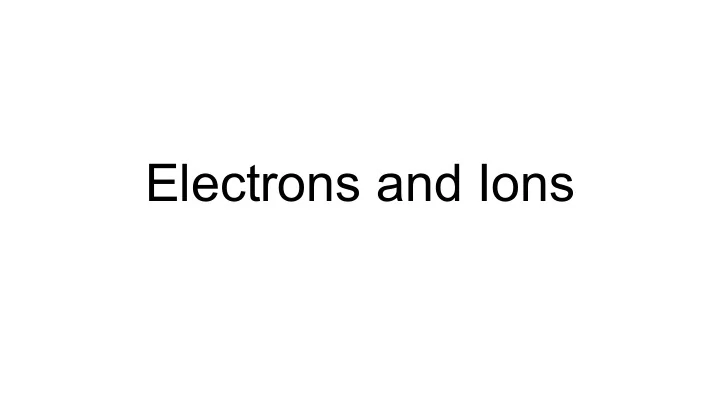

Electrons and Ions
Isotopes...do on index card Carbon-12 accounts for 99.45% of all of the carbon atoms, while carbon-14 only accounts for the remaining 0.55%. Since the carbon-12 isotope is more abundant, its mass is weighted more in the calculation of carbon’s atomic mass. What is the average atomic mass of carbon?
Any last minute questions before the quiz?
Europium has two stable isotopes: Europium-151 with a mass of 150.9196 amu and Europium-153 with a mass of 152.9209. If elemental Europium is found to have a mass of 151.96 amu on earth, calculate the percent of each of the two isotopes (with the correct number of significant figures).
Chlorine has two stable isotopes Cl-35 and Cl-37. Chlorine has the atomic mass of 35.453 amu, what can you tell me about the relative abundance of each isotope found in a sample of chlorine?
Ticket out the door State how many valence electrons Bromine (Br) has and write the Bohr notation for its complete electron configuration.
Valence Electrons Electrons in the outermost shell, these electrons are the electrons that participate in chemical reactions (the formation of new chemical bonds). An atom is most stable when a valence shell is full
Elements with the same number of valence electrons will behave very similarly
Excited State Electrons can move to a higher energy level if they are heated up enough or hit by light
Bohr Notation for Excited Electron Bromine in the ground state: 2-8-18-7 Bromine with an electron in the excited state: 2-8-18-6-1 or 2-8-17-8
Ions An atom with a positive or negative charge because of the loss or gain of one or more electrons Cations-positive ions...lost one or more electron Anions-negative ions...gained one or more electron
Nucleons A proton or neutron
Bell Ringer On the index card, determine the average atomic mass of element X. It has three known isotopes, X-56, X-58, and X-59. X-56 is found naturally with a percent abundance of 60% while the other two each have percent abundances of 20%. Determine the average atomic mass for element X. If element X had an electron configuration of 2-8-6, how would we draw the Lewis Dot Diagram.
Electrons Electrons are located in energy levels that are specific distances from the nucleus The different energy levels can hold a different number of electron The 1st level=max of 2 electrons The 2nd level=max of 8 electrons The 3rd level=max of 18 electrons The 4th level=max 32 electrons However, the valence shell (the outermost shell with the most energy) will never hold more than 8 electrons
Electrons Important concepts to keep in mind: • Electrons are not static • Electrons respond to outside stimulus • Electrons do exist in quantized orbits of specific fixed energies that are a fixed distance from the nucleus (only found at specific energy levels) • Although it may be impossible to see what a single electron may do, billions and trillions in unison are visible to the human eye
States electrons can exist in Ground State – the state of an atom or molecule in which the electrons occupy the lowest possible energy orbitals available Excited State – an unstable state of an atom or molecule in which energy has been absorbed but not reemitted, raising an electron from the ground state into a higher energy orbital
Electrons can become excited by heating an atom enough or by hitting it with light When electrons return to the ground state from the excited state, they lose energy. The energy they lose is given off in the form of light. And each element has it’s own characteristic light that is emitted. This is called its spectra or line spectra
Do Now Write the electron configuration for the following elements in the ground state and the excited state Calcium Silicon Bromine
Bright-Line Spectra You can compare the known line spectra of elements with the line spectra of an unknown sample to determine what the sample consists of
Ions Atoms are more stable when they have a full valence shell (known as a stable octet) So if an atom has fewer than 8 valence electrons it will react to form a more stable compound Ion -an atom with a positive or negative charge due to the gain or loss of electrons
Metals tend to lose electrons. So they become positive ions, or cations Ex. Calcium has 2 valence electrons. It is easier to lose 2 electrons than gain 6, so Calcium becomes Ca +2 Nonmetals tend to gain electrons. So they become negative ions, or anions Ex. Fluorine has 7 valence electrons. It is easier to gain 1 electron than lose 7, so Fluorine becomes F -1 How do the number of protons and neutrons change when these atoms become an ion?
Ticket-out-the-door On the index card: -Write a Lewis Dot for Sulfur -Write the Bohr notation for Sulfur in the ground state and excited state -What ion is Sulfur likely to form? What is the electron configuration for that ion?
Recommend
More recommend